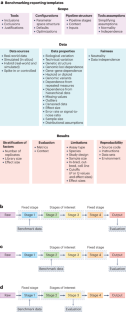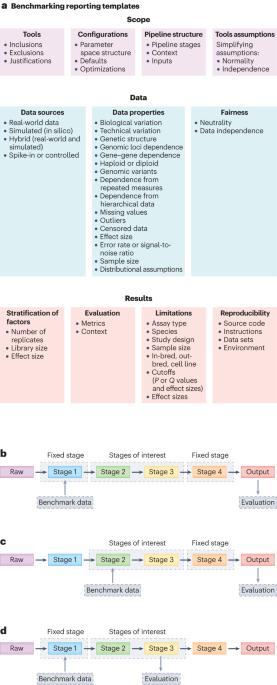omics 基准制定的挑战和最佳实践
IF 39.1
1区 生物学
Q1 GENETICS & HEREDITY
引用次数: 0
摘要
微阵列、高通量测序和质谱仪等技术的进步,使大规模并行测量生物特征成为可能,从而开创了现在已进入第三个十年的全元素时代。由此产生的复杂的分析方法自然促进了全局组学基准行业的发展。基准测试是指在处理和分析大规模生物数据集(如转录组学、蛋白质组学和代谢组学)时,对不同计算或分析技术的性能进行客观比较和评估的过程。在过去的 25 年中,发表了数以千计的 omics 基准研究,该领域已经发展成熟,基准研究的基础已经建立并得到了很好的描述。然而,在这个复杂的领域中生成有意义的基准数据并正确评估性能仍然具有挑战性。在本《综述》中,我们强调了omics 基准测试中一些常见的疏忽和误区。我们还制定了一种方法,以聚焦可以解决的问题,并对那些无法解决的问题保持透明:该方法采用电子表格模板的形式,为全面报告提供指导,旨在与出版物配套使用。此外,我们还提供了基准制定方面的最新进展调查,以及针对常见困难的具体指导。本文章由计算机程序翻译,如有差异,请以英文原文为准。


Challenges and best practices in omics benchmarking
Technological advances enabling massively parallel measurement of biological features — such as microarrays, high-throughput sequencing and mass spectrometry — have ushered in the omics era, now in its third decade. The resulting complex landscape of analytical methods has naturally fostered the growth of an omics benchmarking industry. Benchmarking refers to the process of objectively comparing and evaluating the performance of different computational or analytical techniques when processing and analysing large-scale biological data sets, such as transcriptomics, proteomics and metabolomics. With thousands of omics benchmarking studies published over the past 25 years, the field has matured to the point where the foundations of benchmarking have been established and well described. However, generating meaningful benchmarking data and properly evaluating performance in this complex domain remains challenging. In this Review, we highlight some common oversights and pitfalls in omics benchmarking. We also establish a methodology to bring the issues that can be addressed into focus and to be transparent about those that cannot: this takes the form of a spreadsheet template of guidelines for comprehensive reporting, intended to accompany publications. In addition, a survey of recent developments in benchmarking is provided as well as specific guidance for commonly encountered difficulties. In this Review, the authors summarize and discuss guidelines for omics benchmarking. They highlight common oversights and difficulties, offer guidance for frequently encountered issues and provide a structured form that can be used for comprehensive reporting of benchmarking studies.
求助全文
通过发布文献求助,成功后即可免费获取论文全文。
去求助
来源期刊

Nature Reviews Genetics
生物-遗传学
CiteScore
57.40
自引率
0.50%
发文量
113
审稿时长
6-12 weeks
期刊介绍:
At Nature Reviews Genetics, our goal is to be the leading source of reviews and commentaries for the scientific communities we serve. We are dedicated to publishing authoritative articles that are easily accessible to our readers. We believe in enhancing our articles with clear and understandable figures, tables, and other display items. Our aim is to provide an unparalleled service to authors, referees, and readers, and we are committed to maximizing the usefulness and impact of each article we publish.
Within our journal, we publish a range of content including Research Highlights, Comments, Reviews, and Perspectives that are relevant to geneticists and genomicists. With our broad scope, we ensure that the articles we publish reach the widest possible audience.
As part of the Nature Reviews portfolio of journals, we strive to uphold the high standards and reputation associated with this esteemed collection of publications.
 求助内容:
求助内容: 应助结果提醒方式:
应助结果提醒方式:


